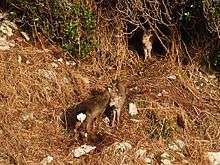Lundy
| Site of Special Scientific Interest | |
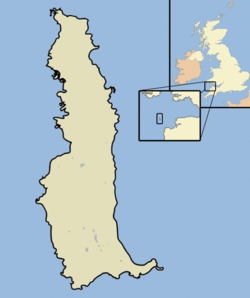 | |
| Area of Search | Devon, England |
|---|---|
| Grid reference | SS135460 |
| Interest | Biological |
| Area |
445 ha (1,100 acres) or 4.45 km2 (1.72 sq mi) [1][2] |
| Notification | 1987 |

Lundy is the largest island in the Bristol Channel. It lies 12 miles (19 km) off the coast of Devon, England,[3] in the district of Torridge, about a third of the distance across the channel from Devon, England to South Wales. Lundy gives its name to a British sea area and is one of the islands of England.[4] Lundy has been designated by Natural England as national character area 159, one of England's natural regions.[5]
In 2007, Lundy had a resident population of 28 people, including volunteers. These include a warden, ranger, island manager and farmer, as well as bar and house-keeping staff. Most live in and around the village at the south of the island. Most visitors are day-trippers, although there are 23 holiday properties and a camp site for staying visitors, mostly also around the south of the island.
In a 2005 opinion poll of Radio Times readers, Lundy was named as Britain's tenth greatest natural wonder. The entire island has been designated as a Site of Special Scientific Interest[6] and it was England's first statutory Marine Nature reserve, and the first Marine Conservation Zone,[7] because of its unique flora and fauna.[8] It is managed by the Landmark Trust on behalf of the National Trust.
History

The name Lundy is believed to come from the old Norse word for "puffin island" (Lundey), lundi being the Old Norse word for a puffin and ey, an island,[9] although an alternative explanation has been suggested with Lund referring to a copse, or wooded area.[10]
Lundy has evidence of visitation or occupation from the Neolithic period onward, with Mesolithic flintwork, Bronze Age burial mounds, four inscribed gravestones from the early medieval period,[11][12] and an early medieval monastery (possibly dedicated to St Elen or St Helen).
Beacon Hill Cemetery
Beacon Hill Cemetery was excavated by Charles Thomas in 1969.[13] The cemetery contains four inscribed stones, dated to the 5th or 6th century AD. The site was originally enclosed by a curvilinear bank and ditch, which is still visible in the south west corner. However, the other walls were moved when the Old Light was constructed in 1819. Celtic Christian enclosures of this type were common in Western Britain and are known as Llans in Welsh and Lanns in Cornish. There are surviving examples in Luxulyan, in Cornwall; Mathry, Meidrim and Clydau in Wales; and Stowford, Jacobstowe, Lydford and Instow, in Devon.
Thomas proposed a five-stage sequence of site usage: (1) An area of round huts and fields. These huts may have fallen into disuse before the construction of the cemetery. (2) The construction of the focal grave, an 11 by 8 ft (3.4 by 2.4 m) rectangular stone enclosure containing a single cist grave. The interior of the enclosure was filled with small granite pieces. Two more cist graves located to the west of the enclosure may also date from this time. (3) Perhaps 100 years later, the focal grave was opened and the infill removed. The body may have been moved to a church at this time. (4) & (5) Two further stages of cist grave construction around the focal grave.
23 cist graves were found during this excavation. Considering that the excavation only uncovered a small area of the cemetery, there may be as many as 100 graves.
Inscribed stones

Four Celtic inscribed stones have been found in Beacon Hill Cemetery:
- 1400 OPTIMI,[13] or TIMI;[14] the name Optimus is Latin and male. Discovered in 1962 by D. B. Hague.[15]
- 1401 RESTEVTAE,[13] or RESGEVT[A],[14] Latin, female i.e. Resteuta or Resgeuta. Discovered in 1962 by D. B. Hague.[15]
- 1402 POTIT[I],[13] or [PO]TIT,[14] Latin, male. Discovered in 1961 by K. S. Gardener and A. Langham.[15]
- 1403 --]IGERNI [FIL]I TIGERNI,[13] or—I]GERNI [FILI] [T]I[G]ERNI,[14] Brittonic, male i.e. Tigernus son of Tigernus. Discovered in 1905.[15]
Knights Templar
Lundy was granted to the Knights Templar by Henry II in 1160. The Templars were a major international maritime force at this time, with interests in North Devon, and almost certainly an important port at Bideford or on the River Taw in Barnstaple. This was probably because of the increasing threat posed by the Norse sea raiders; however, it is unclear whether they ever took possession of the island. Ownership was disputed by the Marisco family who may have already been on the island during King Stephen's reign. The Mariscos were fined, and the island was cut off from necessary supplies.[16] Evidence of the Templars' weak hold on the island came when King John, on his accession in 1199, confirmed the earlier grant.[17]
Marisco family

In 1235 William de Marisco was implicated in the murder of Henry Clement, a messenger of Henry III.[18] Three years later, an attempt was made to kill Henry III by a man who later confessed to being an agent of the Marisco family. William de Marisco fled to Lundy where he lived as a virtual king. He built a stronghold in the area now known as Bulls' Paradise with 9 feet (3 m) thick walls.[17] In 1242, Henry III sent troops to the island. They scaled the island's cliff and captured William de Marisco and 16 of his "subjects". Henry III built the castle (sometimes referred to as the Marisco Castle) in an attempt to establish the rule of law on the island and its surrounding waters.[19] At some point in the 13th century the monks of the Cistercian order at Cleeve Abbey held the rectory of the island.[20]
Piracy
Over the next few centuries, the island was hard to govern. Trouble followed as both English and foreign pirates and privateers – including other members of the Marisco family – took control of the island for short periods. Ships were forced to navigate close to Lundy because of the dangerous shingle banks in the fast flowing River Severn and Bristol Channel, with its tidal range of 27 feet (8.2 m),[21][22] one of the greatest in the world.[23][24] This made the island a profitable location from which to prey on passing Bristol-bound merchant ships bringing back valuable goods from overseas.[25]
In 1627 Barbary Pirates from the Republic of Salé occupied Lundy for five years. The North African invaders, under the command of Dutch renegade Jan Janszoon, flew an Ottoman flag over the island. Some captured Europeans were held on Lundy before being sent to Algiers as slaves.[26][27][28][29] From 1628 to 1634 the island was plagued by pirate ships of French, Basque, English and Spanish origin. These incursions were eventually ended by Sir John Penington, but in the 1660s and as late as the 1700s the island still fell prey to French privateers.[30]
Civil war
In the English Civil War, Thomas Bushell held Lundy for King Charles I, rebuilding Marisco Castle and garrisoning the island at his own expense. He was a friend of Francis Bacon, a strong supporter of the Royalist cause and an expert on mining and coining. It was the last Royalist territory held between the first and second civil wars. After receiving permission from Charles I, Bushell surrendered the island on 24 February 1647 to Richard Fiennes, representing General Fairfax.[31] In 1656, the island was acquired by Lord Saye and Sele.[32]


18th and 19th centuries
The late 18th and early 19th centuries were years of lawlessness on Lundy, particularly during the ownership of Thomas Benson (1708-1772), a Member of Parliament for Barnstaple in 1747 and Sheriff of Devon, who notoriously used the island for housing convicts whom he was supposed to be deporting. Benson leased Lundy from its owner, John Leveson-Gower, 1st Earl Gower (1694–1754) (who was an heir of the Grenville family of Bideford and of Stowe, Kilkhampton in Cornwall), at a rent of £60 per annum and contracted with the Government to transport a shipload of convicts to Virginia, but diverted the ship to Lundy to use the convicts as his personal slaves. Later Benson was involved in an insurance swindle. He purchased and insured the ship Nightingale and loaded it with a valuable cargo of pewter and linen. Having cleared the port on the mainland, the ship put into Lundy, where the cargo was removed and stored in a cave built by the convicts, before setting sail again. Some days afterwards, when a homeward-bound vessel was sighted, the Nightingale was set on fire and scuttled. The crew were taken off the stricken ship by the other ship, which landed them safely at Clovelly.[33]
Sir Vere Hunt, 1st Baronet of Curragh, a rather eccentric Irish politician and landowner, and unsuccessful man of business, purchased the island from John Cleveland in 1802 for £5,270 (£424,400 today). Sir Vere Hunt planted in the island a small, self-contained Irish colony with its own constitution and divorce laws, coinage and stamps. The tenants came from Sir Vere Hunt's Irish estate and they experienced agricultural difficulties while on the island. This led Sir Vere Hunt to seek someone who would take the island off his hands, failing in his attempt to sell the island to the British Government as a base for troops. After the 1st Baronet's death his son, Sir Aubrey (Hunt) de Vere, 2nd Baronet, also had great difficulty in securing any profit from the property. In the 1820s John Benison agreed to purchase the island for £4,500 but then refused to complete sale as he felt that the 2nd Baronet could not make out a good title in respect of the sale terms, namely that the island was free from tithes and taxes.[34]
William Hudson Heaven purchased Lundy in 1834, as a summer retreat and for the shooting, at a cost of 9,400 guineas (£9,870, or £855,500 today). He claimed it to be a "free island", and successfully resisted the jurisdiction of the mainland magistrates. Lundy was in consequence sometimes referred to as "the kingdom of Heaven". It belongs in fact to the county of Devon, and has always been part of the hundred of Braunton.[32] Many of the buildings on the island today, including St. Helena's Church, designed by the architect John Norton, and Millcombe House (originally known simply as the Villa), date from the Heaven period. The Georgian-style villa was built in 1836.[35] However, the expense of building the road from the beach (no financial assistance being provided by Trinity House, despite their regular use of the road following the construction of the lighthouses), the villa and the general cost of running the island had a ruinous effect on the family's finances, which had been damaged by reduced profits from their sugar plantations in Jamaica.
In 1957 a message in a bottle from one of the seamen of the HMS Caledonia was washed ashore between Babbacombe and Peppercombe in Devon. The letter, dated 15 August 1843 read: "Dear Brother, Please e God i be with y against Michaelmas. Prepare y search Lundy for y Jenny ivories. Adiue William, Odessa". The bottle and letter are on display at the Portledge Hotel at Fairy Cross, in Devon, England. The Jenny was a three-masted schooner reputed to be carrying ivory and gold dust that was wrecked on Lundy (at a place thereafter called Jenny's Cove) on 20 February 1797. The ivory was apparently recovered some years later but the leather bags supposed to contain gold dust were never found.[36][37]
20th and 21st centuries
William Heaven was succeeded by his son the Reverend Hudson Grosset Heaven who, thanks to a legacy from Sarah Langworthy (née Heaven), was able to fulfill his life's ambition of building a stone church on the island. St Helen's was completed in 1896, and stands today as a lasting memorial to the Heaven period. It has been designated by English Heritage a Grade II listed building.[38] He is said to have been able to afford either a church or a new harbour. His choice of the church was not however in the best financial interests of the island. The unavailability of the money for re-establishing the family's financial soundness, coupled with disastrous investment and speculation in the early 20th century, caused severe financial hardship.[39]
Hudson Heaven died in 1916, and was succeeded by his nephew, Walter Charles Hudson Heaven.[40] With the outbreak of the First World War, matters deteriorated seriously, and in 1918 the family sold Lundy to Augustus Langham Christie. In 1924, the Christie family sold the island along with the mail contract and the MV Lerina to Martin Coles Harman, who proclaimed himself a king. Harman issued two coins of Half Puffin and One Puffin denominations in 1929, nominally equivalent to the British halfpenny and penny, resulting in his prosecution under the United Kingdom's Coinage Act of 1870. The House of Lords found him guilty in 1931, and he was fined £5 with fifteen guineas (£5 + £15.75) expenses. The coins were withdrawn and became collectors' items. In 1965 a "fantasy" restrike four-coin set, a few in gold, was issued to commemorate 40 years since Harman purchased the island.[41] Harman's son, John Pennington Harman was awarded a posthumous Victoria Cross during the Battle of Kohima, India in 1944. There is a memorial to him at the VC Quarry on Lundy. Martin Coles Harman died in 1954.
Residents did not pay taxes to the United Kingdom and had to pass through customs when they travelled to and from Lundy Island.[42] Although the island was ruled as a virtual fiefdom, its owner never claimed to be independent of the United Kingdom, in contrast to later territorial "micronations".
Following the death of Harman's son Albion in 1968,[43] Lundy was put up for sale in 1969. Jack Hayward, a British millionaire, purchased the island for £150,000 (£2,227,000 today) and gave it to the National Trust,[41] who leased it to the Landmark Trust. The Landmark Trust has managed the island since then, deriving its income from arranging day trips, letting out holiday cottages and from donations. In May 2015 a sculpture by Antony Gormley was erected on Lundy. It is one of five life-sized sculptures, Land, placed near the centre and at four compass points of the UK in a commission by the Landmark Trust, to celebrate its 50th anniversary. The others are at Lowsonford (Warwickshire), Saddell Bay (Scotland), the Martello Tower (Aldeburgh, Suffolk), and Clavell Tower (Kimmeridge Bay, Dorset).[44][45]
The island is visited by over 20,000 day-trippers a year, but during September 2007 had to be closed for several weeks owing to an outbreak of Norovirus.[46]
Wreck of Battleship Montagu
_Aground_Lundy_Island_1906.jpg)
A naval footnote in the history of Lundy was the wreck of the Royal Navy battleship HMS Montagu. Steaming in heavy fog, she ran hard aground near Shutter Rock on the island's southwest corner at about 2:00 a.m. on 30 May 1906.[47] Thinking they were aground at Hartland Point on the English mainland, a landing party went ashore for help, only finding out where they were after encountering the lighthouse keeper at the island's north light.
_Heavy_Fittings_Removed_1906.jpg)
Strenuous efforts by the Royal Navy to salvage the badly damaged battleship during the summer of 1906 failed, and in 1907 it was decided to give up and sell her for scrap. Montagu was scrapped at the scene over the next fifteen years. Diving clubs still visit the site, where armour plate and live 12-inch (305-millimetre) shells remain on the seabed.
Remains of a German Heinkel 111H bomber
During the Second World War two German Heinkel He 111 bombers crash landed on the island in 1941. The first was on 3 March, when all the crew survived and were taken prisoner. The second was on 1 April when the pilot was killed and the other crew members were taken prisoner.[48] The second plane had bombed a British ship and one engine was damaged by anti aircraft fire, forcing it to crash land. A few remains can be found on the crash site. Reportedly to avoid reprisals the crew concocted a story that they were on a reconnaissance mission.[49]
Geography
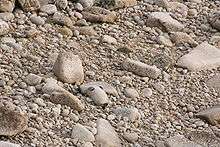
The island of Lundy is 3 miles (5 km) long from north to south by a little over 0.6 miles (1 km) wide, with an area of 1,100 acres (450 ha).[1][2] The highest point on Lundy is Beacon Hill, 469 feet (143 m) above sea level,.[50] A few yards off the northeastern coast is Seal's Rock which is so called after the seals which rest on and inhabit the islet.[51][52] It is less than 55 yards (50 m) wide.[52] Near the jetty is a small pocket beach.
Geology
The island is primarily composed of granite of 50±3 to 54±2 million years[53] (from the Eocene epoch), with slate at the southern end; the plateau soil is mainly loam, with some peat.[6][54] Among the igneous dykes cutting the granite are a small number composed of a unique orthophyre. This was given the name Lundyite in 1914, although the term – never precisely defined – has since fallen into disuse.[55][56]
Climate
Lundy island lies on the borderline where the North Atlantic Ocean and the Bristol Channel meet, so it has quite a mild climate. Lundy has cool, wet winters and mild, wet summers. It is often windy.
Ecology
Flora
There is one endemic plant species, the Lundy cabbage (Coincya wrightii), a species of primitive brassica.[57]
By the 1980s the eastern side of the island had become overgrown by rhododendrons (Rhododendron ponticum) which had spread from a few specimens planted in the garden of Millcombe House in Victorian times, but eradication of this non-native plant has been undertaken by volunteers over the past fifteen years in an operation known on the island as "rhody-bashing". The vegetation on the plateau is mainly dry heath, with an area of waved Calluna heath towards the northern end of the island, which is also rich in lichens, such as Teloschistes flavicans and several species of Cladonia and Parmelia. Other areas are either a dry heath/acidic grassland mosaic, characterised by heaths and western gorse (Ulex gallii), or semi-improved acidic grassland in which Yorkshire fog (Holcus lanatus) is abundant. Tussocky (Thrift) (Holcus/Armeria) communities occur mainly on the western side, and some patches of bracken (Pteridium aquilinum) on the eastern side.[6]
Fauna
Terrestrial invertebrates
Two invertebrate taxa are endemic to Lundy, with both feeding on the endemic Lundy cabbage (Coincya wrightii). These are the Lundy cabbage flea beetle (Psylliodes luridipennis), a species of leaf beetle (family Chrysomelidae) and the Lundy cabbage weevil (Ceutorhynchus contractus var. pallipes), a variety of true weevil (family Curculionidae).[58][59] In addition, the Lundy cabbage is the main host of a flightless form of Psylliodes napi (another species of flea beetle) and a wide variety of other invertebrate species which are not endemic to the island.[59] Another resident invertebrate of note is Atypus affinis, the only British species of purseweb spider.[58][60]
Birds
The number of puffins (Fratercula arctica), which may have given the island its name, declined in the late 20th and early 21st centuries, with the 2005 breeding population estimated to be only two or three pairs, as a consequence of depredations by brown and black rats (Rattus rattus) (which have now been eliminated) and possibly also as a result of commercial fishing for sand eels, the puffins' principal prey. Since 2005, the breeding numbers have been slowly increasing. Adults were seen taking fish into four burrows in 2007,[61] and six burrows in 2008.[62]
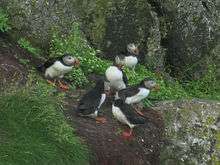
As an isolated island on major migration routes, Lundy has a rich bird life and is a popular site for birdwatching. Large numbers of black-legged kittiwake (Rissa tridactyla) nest on the cliffs, as do razorbill (Alca torda), guillemot (Uria aalge), herring gull (Larus argentatus), lesser black-backed gull (Larus fuscus), fulmar (Fulmarus glacialis), shag (Phalacrocorax aristotelis), oystercatcher (Haematopus ostralegus), skylark (Alauda arvensis), meadow pipit (Anthus pratensis), common blackbird (Turdus merula), robin (Erithacus rubecula) and linnet (Carduelis cannabina). There are also smaller populations of peregrine falcon (Falco peregrinus) and raven (Corvus corax).
Lundy has attracted many vagrant birds, in particular species from North America. The island's bird list totals 317 species.[63] This has included the following species, each of which represents the sole British record: Ancient murrelet, eastern phoebe and eastern towhee. Records of bimaculated lark, American robin and common yellowthroat were also firsts for Britain (American robin has also occurred two further times on Lundy).[63] Veerys in 1987 and 1997 were Britain's second and fourth records, a Rüppell's warbler in 1979 was Britain's second, an eastern Bonelli's warbler in 2004 was Britain's fourth, and a black-faced bunting in 2001 Britain's third.[63]
Other British Birds rarities that have been sighted (single records unless otherwise indicated) are: Little bittern, glossy ibis, gyrfalcon (3 records), little and Baillon's crakes, collared pratincole, semipalmated (5 records), least (2 records), white-rumped and Baird's (2 records) sandpipers, Wilson's phalarope, laughing gull, bridled tern, Pallas's sandgrouse, great spotted, black-billed and yellow-billed (3 records) cuckoos, European roller, olive-backed pipit, citrine wagtail, Alpine accentor, thrush nightingale, red-flanked bluetail, black-eared (2 records) and desert wheatears, White's, Swainson's (3 records), and grey-cheeked (2 records) thrushes, Sardinian (2 records), Arctic (3 records), Radde's and western Bonelli's warblers, Isabelline and lesser grey shrikes, red-eyed vireo (7 records), two-barred crossbill, yellow-rumped and blackpoll warblers, yellow-breasted (2 records) and black-headed (3 records) buntings, rose-breasted grosbeak (2 records), bobolink and Baltimore oriole (2 records).[63]
Mammals
Lundy is home to an unusual range of mammals, almost all introduced, including a distinct breed of wild pony, the Lundy pony. Until recently, Lundy and the Shiant Isles in the Hebrides were the only two places in the UK where the black rat (Rattus rattus) could be found regularly.[64] In the rest of the United Kingdom they have largely been replaced by brown rats except for occasional sightings in port towns and the Thames Estuary.[65][66] It has since been eradicated on the island, in order to protect the nesting seabirds.[67] Other species which have made the island their home include the grey seal (Halichoerus grypus), Sika deer (Cervus nippon), pygmy shrew (Sorex minutus) and feral goats (Capra aegagrus hircus). Unusually, 20% of the rabbits (Leporidae) on the island are melanistic compared with 4% which is typical in the UK. In mid-2006 the rabbit population was devastated by myxomatosis, leaving only 60 pairs from the previous 15–20,000 individuals. Soay sheep (Ovis aries) on the island have been shown to vary their behaviours according to nutritional requirements, the distribution of food and the risk of predation.[68]
Marine habitat
In 1971 a proposal was made by the Lundy Field Society to establish a marine reserve, and the survey was led by Dr Keith Hiscock, supported by a team of students from Bangor University. Provision for the establishment of statutory Marine Nature Reserves was included in the Wildlife and Countryside Act 1981, and on 21 November 1986 the Secretary of State for the Environment announced the designation of a statutory reserve at Lundy.[69]
There is an outstanding variety of marine habitats and wildlife, and a large number of rare and unusual species in the waters around Lundy, including some species of seaweed, branching sponges, sea fans and cup corals.[69]
In 2003 the first statutory No Take Zone (NTZ) for marine nature conservation in the UK was set up in the waters to the east of Lundy island.[70] In 2008 this was declared as having been successful in several ways including the increasing size and number of lobsters within the reserve, and potential benefits for other marine wildlife.[71] However, the no take zone has received a mixed reaction from local fishermen.[72]
On 12 January 2010 the island became Britain's first Marine Conservation Zone designated under the Marine and Coastal Access Act 2009, designed to help to preserve important habitats and species.[8][73][74]
Transport

To the island
There are two ways to get to Lundy, depending on the time of year. In the summer months (April to October) visitors are carried on the Landmark Trust's own vessel, MS Oldenburg, which sails from both Bideford and Ilfracombe. Sailings are usually three days a week, on Tuesdays, Thursdays and Saturdays, with additional sailings on Wednesdays during July and August. The voyage takes on average two hours, depending on ports, tides and weather. The Oldenburg was first registered in Bremen, Germany in 1958 and has been sailing to Lundy since her engine was replaced in 1985.[75]
In the winter months (November to March), the Oldenburg is out of service, and the island is served by a scheduled helicopter service from Hartland Point. The helicopter operates on Mondays and Fridays, with flights between 12 noon and 2 pm. The heliport is a field at the top of Hartland Point, not far from the Beacon.
A grass runway of 435 by 30 yards (398 by 27 m) is available, allowing access to small STOL aircraft skilfully piloted.[76]
Properly equipped and experienced canoeists can kayak to the island from Hartland Point or Lee Bay. This takes 4 to 6 hours depending on wind and tides.
Entrance to Lundy is free for anyone arriving by scheduled transport. Visitors arriving by non-scheduled transport are charged an entrance fee, currently (May 2016) £6.00, and there is an additional charge payable by those using light aircraft. Anyone arriving on Lundy by non-scheduled transport is also charged an additional fee for transporting luggage to the top of the island.
On the island
In 2007, Derek Green, Lundy's general manager, launched an appeal to raise £250,000 to save the mile-long Beach Road, which had been damaged by heavy rain and high seas. The road was built in the first half of the 19th century to provide people and goods with safe access to the top of the island, 120 metres (394 ft) above the only jetty.[77] The fund-raising was completed on 10 March 2009.[78]
Lighthouses
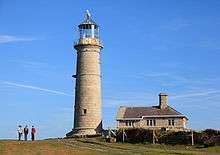
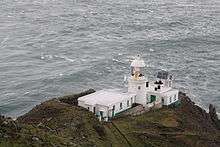 Lundy North Lighthouse | |
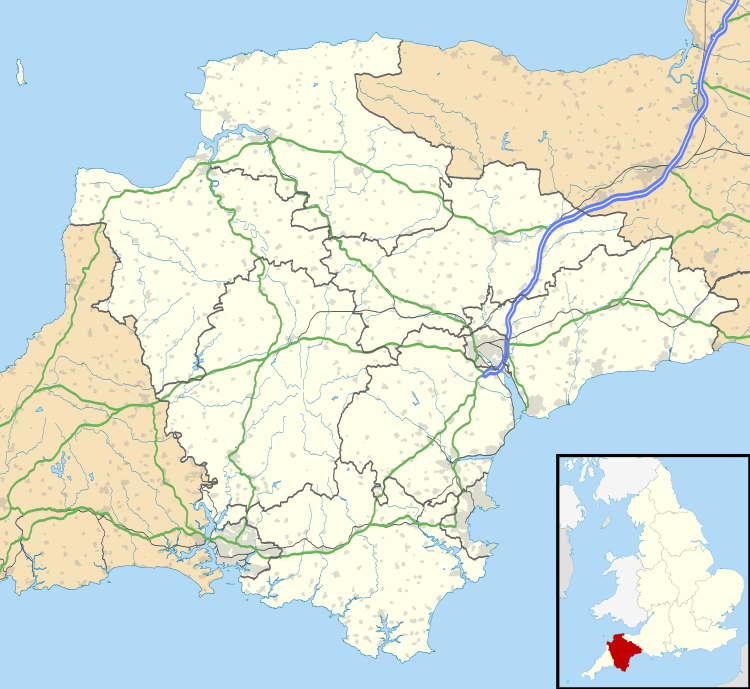 Devon | |
| Location |
Lundy Island Bristol Channel England |
|---|---|
| Coordinates | 51°12′06″N 4°40′38″W / 51.201719°N 4.677257°W |
| Year first constructed | 1897 |
| Automated | 1985 |
| Construction | brick tower |
| Tower shape | cylindrical tower with balcony and lantern attached to 1-storey keeper’s house |
| Markings / pattern | white tower and lantern |
| Height | 17 m (56 ft) |
| Focal height | 48 m (157 ft) |
| Current lens | Orga Rml 302 SA rotating beacon with 6 position lampchanger |
| Intensity | 16,154 candela |
| Range | 17 nmi (31 km) |
| Characteristic | Fl W 15s. |
| Admiralty number | A5616 |
| NGA number | 6244 |
| ARLHS number | ENG 074 |
| Managing agent |
Trinity House[79] [80] |
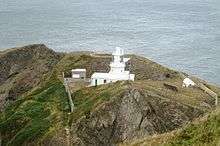 Lundy South Lighthouse | |
| Location |
Lundy Island Bristol Channel England |
|---|---|
| Coordinates | 51°09′43″N 4°39′21″W / 51.162043°N 4.655758°W |
| Year first constructed | 1897 |
| Automated | 1985 |
| Construction | brick tower |
| Tower shape | cylindrical tower with balcony and lantern attached to 1-storey keeper’s house |
| Markings / pattern | white tower and lantern |
| Height | 16 m (52 ft) |
| Focal height | 53 m (174 ft) |
| Current lens | Orga Rml 302 SA rotating beacon with 6 position lampchanger |
| Intensity | 13,000 Candela (South) |
| Range | 15 nmi (28 km) |
| Characteristic | Fl W 5s. |
| Admiralty number | A5618 |
| NGA number | 6248 |
| ARLHS number | ENG-075 |
| Managing agent |
Trinity House[81] [82] |
Foundations for a lighthouse on Lundy were laid in 1787, but the first lighthouse (now known as the Old Light) was not built until Trinity House obtained a 999-year lease in 1819. The 97-foot (30 m) granite tower, on the summit of Chapel Hill, was designed by Daniel Asher Alexander, and built by Joseph Nelson at a cost of £36,000.[83] Because the site, Beacon Hill, is 469 feet (143 m) above sea level,[50] the highest base for a lighthouse in Britain, the light was often obscured by fog. To counter this problem, the Fog Signal Battery[84] was built about 1861.
The lighthouse had two lights; the lower a fixed white light and the upper a quick flashing white light, showing every 60 seconds. However, this quick revolution gave the impression it was a fixed light with no flashes detectable. This may have contributed to the grounding, at Cefn Sidan, of the La Jeune Emma, bound from Martinique to Cherbourg in 1828. 13 of the 19 on board drowned, including Adeline Coquelin, the 12-year-old niece of Napoleon Bonaparte's divorced wife Joséphine de Beauharnais.[85]
Owing to the ongoing complaints about the difficulty of sighting the light in fog, the lighthouse was abandoned in 1897 when the North[86] and South[87] Lundy lighthouses were built. The Old Light and the associated keepers' houses are kept open by the Landmark Trust.[88]
The current North Lundy and South Lundy lighthouses were built in 1897 at the extremities of the island to replace the old lighthouse. Both lighthouses are painted white and are run and maintained by Trinity House.[89]
The North lighthouse is 56 feet (17 m) tall, slightly taller than the south one, and has a focal plane of 157 ft (48 m). It produces a quick white flash every 15 seconds,[88] and was originally lit by a 75 mm (3 in) petroleum vapour burner. Oil was lifted up from a small quay using a sled and winch, and then transported using a small railway (again winch-powered). The remains of this can be still seen, but it was abandoned in 1971 and the lighthouse now uses a discharge bulb fed from the island's main supply.[89] The northern light was modernised in 1991 and converted to solar power, since when the light has been mounted on top of the old fog horn building rather than in the tower.[89]
The South lighthouse has a focal length of 174 feet (53 m) and a quick white flash every 5 seconds.[88] It can be seen as a small white dot from Hartland Point, 11 miles to the south east. It was automated and converted to solar power in 1994.[85] The old fresnel lens has been in use since 2001 in Dungeness Lighthouse.[89]
Electricity supply
There is a small power station comprising three Cummins B and C series diesel engines, offering an approx 150 kVa 3 phase supply to most of the island buildings. Waste heat from the engine jackets is used for a district heating pipe. There are also plans to collect the waste heat from the engine exhaust heat gases to feed into the district heat network to improve the efficiency further.[90] The Power is normally switched off between 0000 and 0630.[91]
Staying on the island
Lundy has 23 holiday properties, sleeping between one and 14 people. These include a lighthouse, a castle and a Victorian mansion. Many of the buildings are constructed from the island's granite.
The island also has a campsite, at the south of the island in the field next to the shop. It has hot and cold running water, with showers and toilets, in an adjacent building.
The island is popular with rock climbers, having the UK's longest continuous slab climb, "The Devil's Slide." [92]
Administration
The island is an unparished area of Torridge district of the English county of Devon.[93] It forms part of the ward of Clovelly Bay.[94][95] It is part of the constituency electing the Member of Parliament for Torridge and West Devon and the South West England constituency for the European Parliament.[95]
Stamps
Owing to a decline in population and lack of interest in the mail contract, the GPO ended its presence on Lundy at the end of 1927.[96] For the next two years Harman handled the mail to and from the island without charge. On 1 November 1929, he decided to offset the expense by issuing two postage stamps (½ puffin in pink and 1 puffin in blue). One puffin is equivalent to one English penny. The printing of Puffin stamps continues to this day and they are available at face value from the Lundy Post Office. One used to have to stick Lundy stamps on the back of the envelope; but Royal Mail now allows their use on the front of the envelope, but placed on the left side, with the right side reserved for the Royal Mail postage stamp or stamps. Lundy stamps are cancelled by a circular Lundy handstamp. The face value of the Lundy Island stamps covers the cost of postage of letters and postcards from the island to the Bideford Post Office on the mainland for onward delivery to their final destination anywhere in the world. The Lundy Post Office gets a bulk rate discount for mailing letters and postcards from Bideford. Lundy stamps are a type of postage stamp known to philatelists as "local carriage labels" or "local stamps". Issues of increasing value were made over the years, including air mail, featuring a variety of people. Many are now highly sought-after by collectors.[97] The market value of the early issues has risen substantially over the years. For the many thousands of annual visitors Lundy stamps have become part of the collection of the many British Local Posts collectors. The first catalogues of these stamps included Gerald Rosen's 1970 Catalogue of British Local Stamps. Later specialist catalogues include Stamps of Lundy Island by Stanley Newman, first published in 1984, Phillips Modern British Locals CD Catalogue, published since 2003, and Labbe's Specialised Guide to Lundy Island Stamps, published since 2005 and now in its 11th Edition. Labbe's Guide is considered the gold standard of Lundy catalogues owing to its extensive approach to varieties, errors, specialised items and "fantasy" issues.[98] There is a comprehensive collection of these stamps in the Chinchen Collection, donated by Barry Chinchen[99] to the British Library Philatelic Collections in 1977 and now held by the British Library. This is also the home of the Landmark Trust Lundy Island Philatelic Archive which includes artwork, texts and essays as well as postmarking devices and issued stamps.[100]
In popular culture
A ship named Lundy Island, 3,095 tons, was captured and sunk on 10 January 1917 by the Seeadler, a windjammer under the German navy, but flying the Norwegian flag.
Lundy island is prominently featured in John Bellairs' juvenile gothic mystery, The Secret of the Underground Room. The plot highlights several geographical and historical points of interest, including the (De) Marisco family. The book was first published in 1990.[101]
Lundy features in the 1919 novel Last of the Grenvilles by Frederick Harcourt Kitchin (under his pseudonym, Bennett Copplestone)
See also
- Barbara Whitaker, former warden.
- Coins of Lundy
- Puffin Island
- List of people on stamps of Lundy
References
- 1 2 "Lundy". Devonbirds. Retrieved 28 May 2014.
- 1 2 Devon.gov.uk
- ↑ "Marine conservation zone 2013 designation: Lundy". gov.UK. Department for Environment, Food & Rural Affairs, Joint Nature Conservation Committee and Natural England. Retrieved 3 March 2015.
- ↑ Collyer, Peter (1998) Rain Later, Good: illustrating the Shipping Forecast. Bradford on Avon: Thomas Reed ISBN 0-901281-33-6
- ↑ NCA 159:Lundy - Key Facts and Data at www.naturalengland.org. Accessed on 8 September 2013
- 1 2 3 "Lundy SSSI citation sheet" (PDF). Natural England. Retrieved 5 September 2007.
- ↑ "Lundy Marine Conservation Zone". Natural England. Retrieved 28 May 2014.
- 1 2 "Lundy Marine Conservation Zone". Lundy Marine Conservation Zone. Retrieved 18 December 2011.
- ↑ "Puffin Island". BBC Radio 4 - The Living World. Retrieved 5 September 2007.
- ↑ "Meaning of lundey". Pete Robson's Lundy Island Site. Retrieved 28 May 2014.
- ↑ See the discussion and bibliography in Elisabeth Okasha, Corpus of early Christian inscribed stones of South-west Britain (Leicester: University Press, 1993), pp. 154-166
- ↑ Lundy Field Society 40th Annual Report for 1989. Pp. 34 - 47.
- 1 2 3 4 5 Charles Thomas, And Shall These Mute Stones Speak? (1994) Cardiff: University of Wales Press
- 1 2 3 4 Elisabeth Okasha, (1993) Corpus of Early Christian Inscribed Stones of South-west Britain. Leicester: University Press
- 1 2 3 4 "Celtic Inscribed Stones Project history". Retrieved 6 January 2008.
- ↑ "Lundy Island Pirates — William de Marisco". FairyJo. Retrieved 6 September 2007.
- 1 2 "Lundy history". Pete Robsons Lundy site. Retrieved 28 May 2014.
- ↑ Maitland, F.W. (April 1895). "The Murder of Henry Clement". The English Historical Review. 10 (38): 294–297. doi:10.1093/ehr/X.XXXVIII.294. JSTOR 547790.
- ↑ "Marisco Castle, Keep and Bailey". Images of England. Retrieved 5 September 2007.
- ↑ Harrison, Stuart A. (2000). Cleeve Abbey. English Heritage. p. 26. ISBN 1-85074-760-1.
- ↑ Admiralty (1891). Sailing Directions for the West Coast of England from the Scilly Islands to the Mull of Galloway, including the Isle of Man. London: Hydrographic Department. p. 54.
- ↑ "Tides and Currents". Lundy Marine Protection Zone. Retrieved 17 December 2013.
- ↑ "Severn Estuary Barrage". UK Environment Agency. 31 May 2006. Archived from the original (PDF) on 30 September 2007. Retrieved 3 September 2007.
- ↑ "Coast: Bristol Channel". BBC. Retrieved 27 August 2007.
- ↑ "Pirate Island". Rodney Broome. Archived from the original on 2008-01-08. Retrieved 6 September 2007.
- ↑ http://www.amazon.co.uk/White-Gold-Forgotten-Africas-European/dp/0340895098 | WWhite Gold: The Forgotten Story of North Africa's One Million European Slaves" by Giles Milton
- ↑ de Bruxelles, Simon (28 February 2007). "Pirates who got away with it". Study of sails on pirate ships. London. Retrieved 25 November 2007.
- ↑ Konstam, Angus (2008). Piracy: the complete history. Osprey Publishing. p. 91. ISBN 978-1-84603-240-0. Retrieved 15 April 2011.
- ↑ Davies, Norman (1996). Europe: A History. Oxford University Press. p. 561. ISBN 978-0-19-820171-7. Retrieved 25 November 2007.
- ↑ Chanter, John Roberts (1877). Lundy island: a monograph, descriptive and historical. Cassell, Petter, and Galpin. pp. 78–89. Retrieved 21 August 2011.
- ↑ Boundy, Wyndham Sydney (1961). Bushell and Harman of Lundy. Bideford: Gazette Printing Service.
- 1 2 "Lundy Community Page". Devon County Libraries. Retrieved 6 September 2007.
- ↑ "Lundy, the Mariscos and Benson.". Retrieved 6 September 2007.
- ↑ "Limerick City Archives, P22, De Vere Papers". Retrieved 25 June 2010.
- ↑ "Millcombe House". Images of England. Retrieved 5 September 2007.
- ↑ Page, John Lloyd Warden, The coasts of Devon and Lundy Island: their towns, villages, scenery, antiquities and legends. London: Horace Cox, 1895, p. 227.
- ↑ Langham, A. F. (1994) The island of Lundy. Stroud: Sutton Publishing, p. 142. ISBN 978-0-7509-0661-6
- ↑ "Church of St Helena". Images of England. Retrieved 5 September 2007.
- ↑ Heaven, Will (5 November 2011). "Lundy: My family and the Kingdom of Heaven". Telegraph. Retrieved 7 July 2016.
- ↑ "Lundy Island". Flags of the World. Archived from the original on 24 January 2005. Retrieved 6 September 2007.
- 1 2 Bruce, Colin R. (1988). Unusual World Coins. 2nd. Edition. KP Books. ISBN 0-87341-116-1.
- ↑ Fogle, Ben (2007). Offshore: In Search of an Island of My Own. Penguin UK. ISBN 9780141930435.
- ↑ "Island owner dies after air lift" (source unknown). 24 June 1968
- ↑ "Land – An art installation for all to mark Landmark's 50th year". Landmark Trust. Retrieved 8 July 2015.
- ↑ "Sir Antony Gormley sculptures placed at five UK beauty spots". BBC. Retrieved 8 July 2015.
- ↑ de Bruxelles, Simon (21 September 2007). "Island closes down after stomach bug". Times Online. London. Retrieved 29 September 2007.
- ↑ Burt, R. A. (1988). British Battleships 1889-1904. Annapolis, Maryland: Naval Institute Press. pp. 205–206. ISBN 0-87021-061-0.
- ↑ Gade, Mary; Michael, Harman, (1995). Lundy's War. Appledore: Mary Gade. ISBN 978-0-9525602-0-3.
- ↑ "Heinkel He-111 3911 - Lundy". AIRCRAFT WRECKS in the UK & Ireland. Retrieved 3 September 2010.
- 1 2 "Geography Place and People: On the Map". Channel 4. Retrieved 26 February 2015.
- ↑ "LUNDY ISLAND" in A Handbook for Travellers in Devonshire (9th ed.), London, J. Murray, (1879).
- 1 2 "Diving". Lundy Field Society. Retrieved 28 May 2014.
- ↑ Edmonds, E.A.; McKeown, M.C.; Williams, M. (1975). British Regional Geology, South-West England (4th ed.). British Geological Survey. ISBN 0-11-880713-7.
- ↑ "Lundy island, virtual tour — geology". Natural England. Retrieved 5 September 2007.
- ↑ Mineralogical Society of Great Britain and Ireland, Meeting held January 27, 1938
- ↑ Hall, T. C. F. (1915). "Summer Programme of the Geological Survey". 53 (56).
- ↑ "The Lundy Cabbage". Lundy Field Society. Retrieved 28 May 2014.
- 1 2 "Lundy island, virtual tour — wildlife". Natural England. Archived from the original on 20 November 2008. Retrieved 5 September 2007.
- 1 2 Compton, S. G.; Key, R. S. (2000). "Coincya wrightii (O.E. Schulz) Stace (Rhynchosinapis wrightii (O.E. Schulz) Dandy ex A.R. Clapham)". Journal of Ecology. 88 (3): 535. doi:10.1046/j.1365-2745.2000.00477.x.
- ↑ "Lundy: A Wildlife Haven". BBC. 15 August 2010. Retrieved 19 August 2014.
- ↑ Saunders, Nicola (2007 in press): Lundy Warden's Report for 2007 Annual Report of the Lundy Field Society 58
- ↑ Saunders, Nicola (personal communication)
- 1 2 3 4 Davis, Tim & Tim Jones (2007), The Birds of Lundy ISBN 0-9540088-7-1
- ↑ "British Isles Exotic and Introduced Mammals". World of European Exotic and Introduced Species. Retrieved 15 September 2012.
- ↑ "Black Rat". People's trust for endangered species. Retrieved 28 May 2014.
- ↑ "Black Rat". Twycross Zoo. Retrieved 15 September 2012.
- ↑ "Rattus rattus". Biological Records Centre. Retrieved 15 September 2012.
- ↑ Hopewell, L; Rossiter, R.; Blower, E.; Leaver, L.; Goto, K. (September 2005). "Grazing and vigilance by Soay sheep on Lundy island: Influence of group size, terrain and the distribution of vegetation". Behavioural Processes. 70 (2): 186–193. doi:10.1016/j.beproc.2005.04.009. PMID 15963661. Retrieved 5 September 2007.
- 1 2 "Lundy Island Marine Nature Reserve". Lundy Field Society. Retrieved 28 May 2014.
- ↑ "Protection for Lundy Island's sea life boosted: The First No Take Zone in UK confirmed by Government". Press Release. Natural England. Retrieved 16 July 2008.
- ↑ "Natural England says it's time to sink or swim to save our seas". Press Release. Natural England. Retrieved 28 May 2014.
- ↑ "Fishing ban brings seas to life". BBC News. BBC. 16 July 2008. Retrieved 16 July 2008.
- ↑ "Lundy sea is England's first Maritime Conservation Zone". BBC. 12 January 2010. Retrieved 12 January 2010.
- ↑ "Lundy Island becomes England's first marine conservation zone". London: The Guardian. 12 January 2010. Retrieved 12 January 2010.
- ↑ "MS Oldenburg at captainsvoyage". Retrieved 8 June 2009.
- ↑ UK VFR flight guide, 2003 edition, ISBN 1-874783-62-4
- ↑ Morris, Steven (5 September 2007). "£250,000 plea to save remote island's lifeline". The Guardian. London. Retrieved 5 September 2007.
- ↑ "Lundy road appeal completed". The Landmark Trust. Retrieved 17 March 2009.
- ↑ Lundy Island North The Lighthouse Directory. University of North Carolina at Chapel Hill. Retrieved May 2nd, 2016
- ↑ Lundy Island North Lighthouse Trinity House. Retrieved May 2nd, 2016
- ↑ Lundy Island South The Lighthouse Directory. University of North Carolina at Chapel Hill. Retrieved May 2nd, 2016
- ↑ Lundy South Lighthouse Trinity House. Retrieved May 2nd, 2016
- ↑ "Disused lighthouse and keeper's house.". Images of England. Retrieved 5 September 2007.
- ↑ "Fog Signal Battery". Images of England. Retrieved 5 September 2007.
- 1 2 "The history of Devon's lighthouses". Local history. BBC Devon. Retrieved 9 September 2010.
- ↑ "Lundy North Lighthouse incl Engine House and Accom block". Images of England. Retrieved 5 September 2007.
- ↑ "Lundy South Lighthouse incl. Engine House and Accom block". Images of England. Retrieved 5 September 2007.
- 1 2 3 Rowlett, Russ. "Lundy Island (Old Light)". University of North Carolina at Chapel Hill. Retrieved 9 September 2010.
- 1 2 3 4 "Lundy North & South Lighthouses". Trinity House. Retrieved 2 May 2010.
- ↑ Green, Derek. "Lundy General Managers Report for 2005" (PDF). Lundy. p. 14. Retrieved 7 July 2016.
- ↑ "Lundy Island Before You Depart Guide 2016" (PDF). Landmark Trust. Retrieved 16 February 2016.
- ↑ http://www.ukclimbing.com/logbook/c.php?i=31090
- ↑ "North Devon District Council & Torridge District Council Core Strategy DPDs: Evidence Base" (PDF). Community Appraisals and Parish Plans in Torridge. North Devon Council. pp. 15–16. Retrieved 27 December 2009.
- ↑ "The District of Torridge (Electoral Changes) Order 1999" (PDF). UK Statutory Instruments. Retrieved 5 September 2007.
- 1 2 Ordnance Survey Election Maps
- ↑ "Lundy Puffin Postage Stamps". Stamp Collecting Blog. Retrieved 20 September 2014. With images of "puffin" stamps.
- ↑ "Lundy Island Cinderella". King George V Silver Jubilee. Retrieved 28 September 2007.
- ↑ "The Lundy Changeling?". Lost Post Collectors Society. Retrieved 7 July 2016.
- ↑ Chinchen, Barry N D (1969). "A catalogue of Lundy stamps". Eastleigh, Hants.: duplicated by Barry N. D. Chinchen. OCLC 558737398., British Library shelfmark X.512/621
- ↑ Philatelic Research at the British Library by David Beech
- ↑ "Bellairsia : Celebrating John Bellairs". bellairsia.com.
Further reading
- Sack, John (2000). Report from Practically Nowhere. ISBN 0-595-08918-6.
- Davis, Tim & Jones, Tim (2007) The Birds of Lundy; illustrated by Mike Langman. Berrynarbor: Devon Bird Watching & Preservation Society and Lundy Field Society, ISBN 0-9540088-7-1
External links
| Wikimedia Commons has media related to Lundy. |
| Wikivoyage has a travel guide for Lundy. |
 "Lundy". Encyclopædia Britannica. 17 (11th ed.). 1911.
"Lundy". Encyclopædia Britannica. 17 (11th ed.). 1911.- Official website
- Lundy Field Society
- Lundy Birds
- Pete Robsons Lundy Island Site
- LundyCam
- Lundy Marine Reserve at Protect Planet Ocean
- More pictures of Lundy Island
- A trip to Devon's 'Puffin Island', Fast Track video feature story about Lundy, 4:15 (2011-09-23)
- Lundy Isle (1956) from British Pathé at YouTube
Coordinates: 51°10′N 4°40′W / 51.167°N 4.667°W
